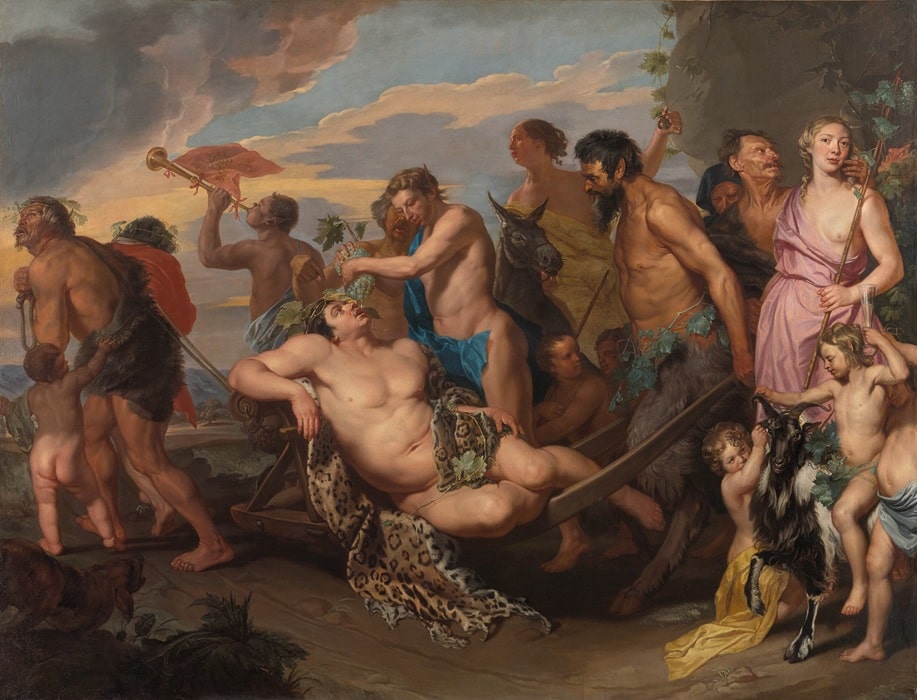Repressed, forgotten, celebrated: the Kunsthistorisches Museum in Vienna is presenting the most comprehensive exhibition to date of the Flemish Baroque painter Michaelina Wautier (c.1614–1689) – one of the most important rediscoveries in recent art history. Following in the tradition of Rubens and Van Dyck, she is rightly celebrated for her brilliant brushwork, her versatility, her wide range of pictorial themes, and the self-assurance with which she depicted male bodies and their anatomy, which was extraordinary for a female painter of her time. Almost all of Wautier’s surviving works are now being presented in Vienna for the first time, including paintings that have never before been shown in public.
Image above: The Triumph of Bacchus, Michaelina Wautier, c. 1655–59, Oil on canvas, 271.5 × 355.5 cm, Kunsthistorisches Museum,, Picture Gallery, © KHM-Museumsverband.
An unusual case in art history
Michaelina Wautier was an exceptional artist of the seventeenth century. Nevertheless, her work was underestimated, forgotten, or attributed to male colleagues for centuries. At a time when women artists were mainly engaged in still life or genre painting, Wautier confidently excelled in the demanding field of history painting. Her monumental The Triumph of Bacchus, for example, was mistakenly attributed to Rubens’s pupils or even Luca Giordano until the 1960s – too large, too powerful, too many nude male bodies for it to have been painted by a woman, as women were generally barred from art classes where nude drawing was taught. Today, the work is considered an icon and a centrepiece of the Picture Gallery at the Kunsthistorisches Museum. Wautier’s portraits, altarpieces, and allegories not only exceed the expectations of women artists at the time, but also testify to her extraordinary originality, subtle humour, and remarkable courage.
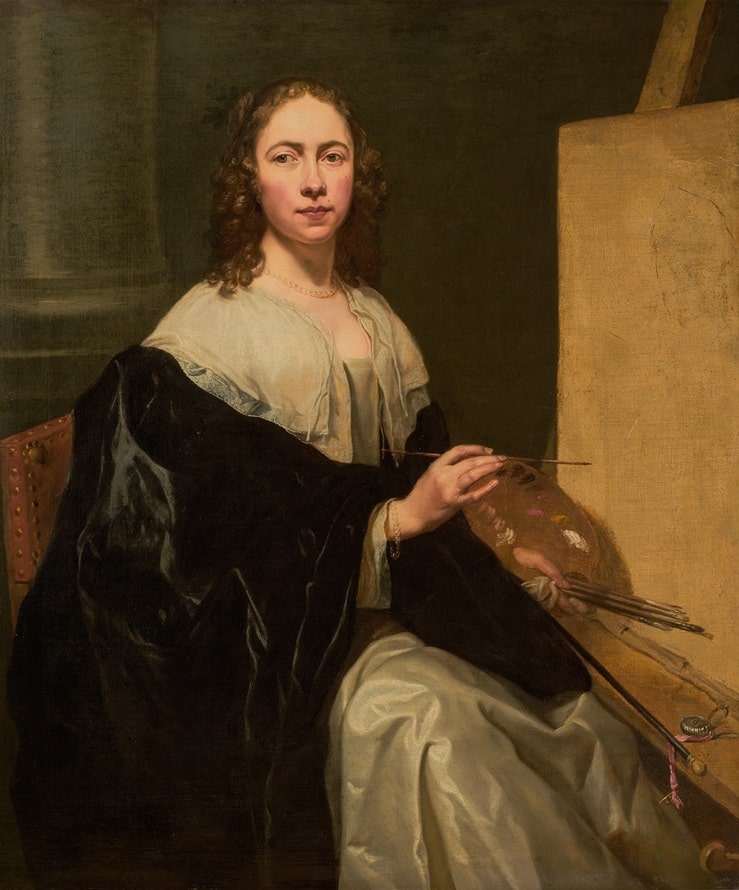
Art history as a journey of discovery
Much of Wautier’s life remains a mystery. Presumably born into an educated and financially independent family from Mons, the painter lived in an age of political unrest and social restrictions for women. Despite not having access to formal training or the backing of a well established family of artists, she nevertheless managed to make her way into the intellectual and artistic circles of the Habsburg court in Brussels.
There, she lived with her older brother Charles Wautier, who was also a painter. It seems likely that they shared a studio, but whether they collaborated – on large-scale works, for example – remains a subject of research. The fact that she never married may well have been a deliberate choice – for the sake of art.
‘We hardly have any biographical data, documents, or letters, but we do have her paintings. That is enough to bring one of the most powerful women artists of her age back into the spotlight’, says curator Gerlinde Gruber.
The Habsburg governor of Brussels and great art collector Archduke Leopold Wilhelm acquired her works. Yet there is no contemporary commentary on her art. Nor are there any letters or other documents written in her own hand. What we do know about Michaelina Wautier comes almost exclusively from her paintings – and from her signatures. Unlike many women artists of her day, she signed with her full name: Michaelina Wautier – not Michelle, but in its Latinised form – which may have been a way of emphasising both her education and her independence. In two of her works, she went even further: with the rare signature invenit et fecit – ‘conceived and executed’ – she actively countered the prejudice of the time that women lacked creative imagination.
Michaelina Wautier’s work is exemplary of many women artists whose achievements have been ignored for centuries.
Largest survey of her work in Vienna
The exhibition was developed in cooperation with the Royal Academy of Arts in London. It makes Wautier’s extraordinary skill and the artistic quality of her paintings evident. With 29 paintings, one signed drawing, and a print based on a lost work, the Kunsthistorisches Museum is presenting the most comprehensive exhibition of the artist’s oeuvre to date. Her works are reassessed and placed in dialogue with antiquity, Rubens, Van Dyck, and other masters of her time.
Altogether, the exhibition brings together around 80 high-calibre works and realia. Thanks to Archduke Leopold Wilhelm’s collecting activities, the Kunsthistorisches Museum now holds the world’s largest museum collection of Wautier paintings. In addition to The Triumph of Bacchus, these include the paintings St. Joachim Reading, St. Joseph, and St. Joachim. They are complemented by loans from major Austrian and international institutions as well as private collections.
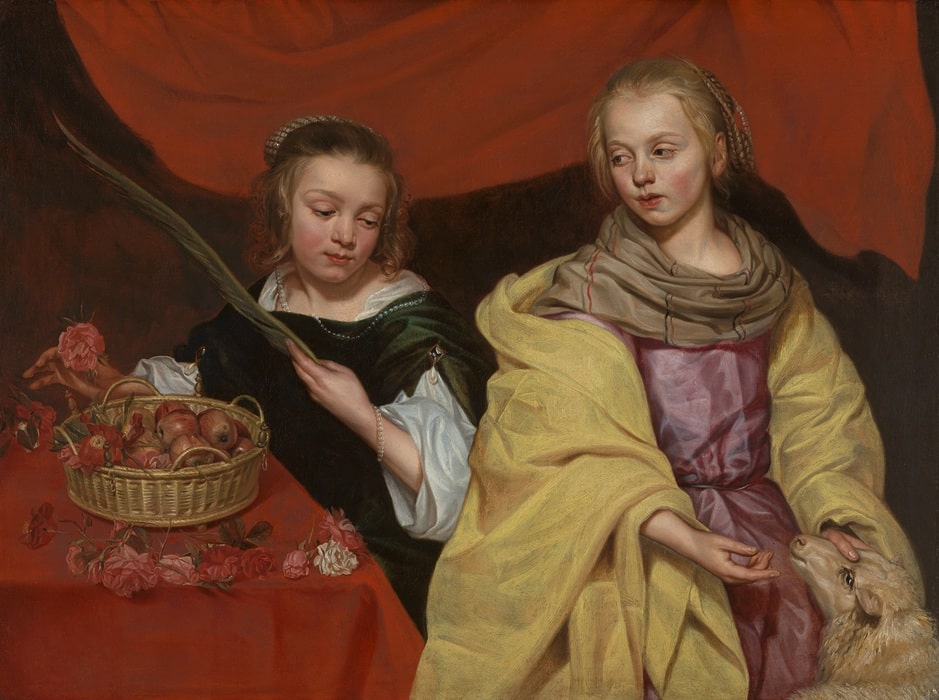
Highlights include Wautier’s famous series The Five Senses, which is being shown in its entirety for the first time in Europe (Rose-Marie and Eijk Van Otterloo Collection), her SelfPortrait (private collection), Flower Garland with Butterfly (Het Noordbrabants Museum, ’sHertogenbosch, on permanent loan from a private collection), Two Girls as St. Agnes and St. Dorothy (Royal Museum of Fine Arts Antwerp – Flemish Community), Boys Blowing Bubbles (Seattle Art Museum, gift of Mr. Floyd Naramore), The Education of the Virgin (private collection, courtesy of the Hoogsteder Museum Foundation), and Portrait of Martino Martini (The Klesch Collection). Other important loans come from the Austrian National Library in Vienna, the University Library of Vienna, The Phoebus Foundation, the Royal Museums of Fine Arts of Belgium in Brussels, the Royal Collection Trust in London, the Rijksmuseum in Amsterdam, and private lenders.
Exhibition tour – Michaelina Wautier, Painter
The self-assured signature & images as evidence
When sources are lacking, image analysis can offer insight: Michaelina Wautier worked through influences from Van Dyck, Van Loon, and De Crayer in a personal and often subtle way – between elegance, light and dark contrasts, and echoes of Caravaggio’s style.
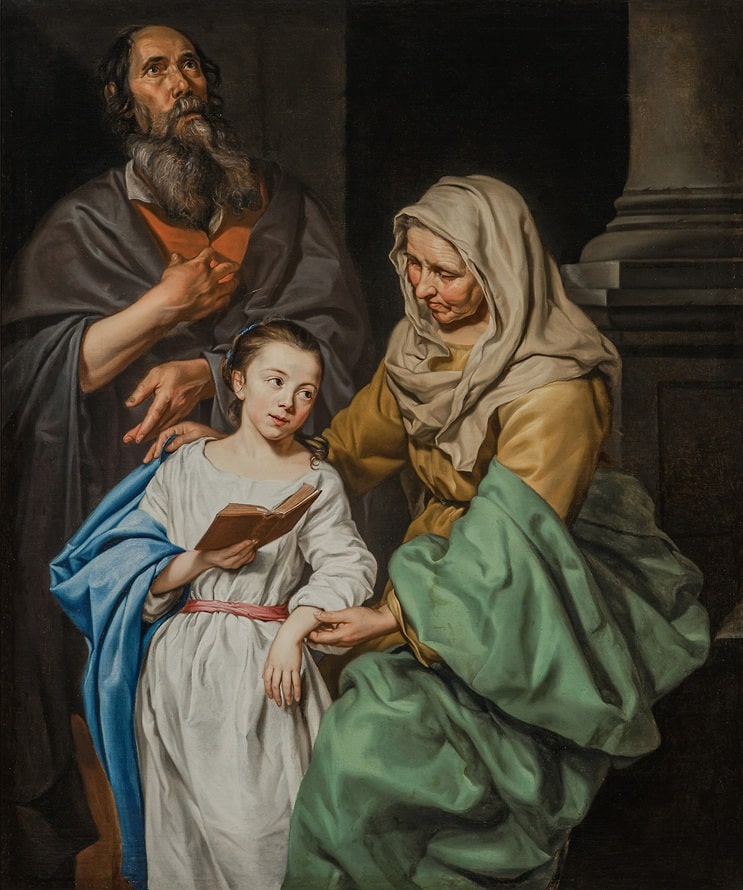
The first room opens the exhibition with multi-layered works on biblical themes and features two showpieces. In The Education of the Virgin (1656), depicting the young Mary learning to read, Wautier created a thoughtful composition with masterful use of light. She must have been especially proud of this work, as she signed it prominently – including the year and a note that she had conceived and executed it (Latin: invenit et fecit). Two Girls as St. Agnes and St. Dorothy (1655) demonstrates Wautier’s flair for psychological depth and spiritual narrative force.
Patrons and their circle
The second exhibition room focuses on Michaelina Wautier’s portraiture, which demonstrates her close ties to the Brussels court and influential patrons. Portraits of military men and clergy, such as the impressive Portrait of a Military Commander (1646), reveal her psychological acuity and clearly distinguish her style from that of her brother Charles. One highlight is the Portrait of Martino Martini (1654), a Jesuit missionary from Italy.
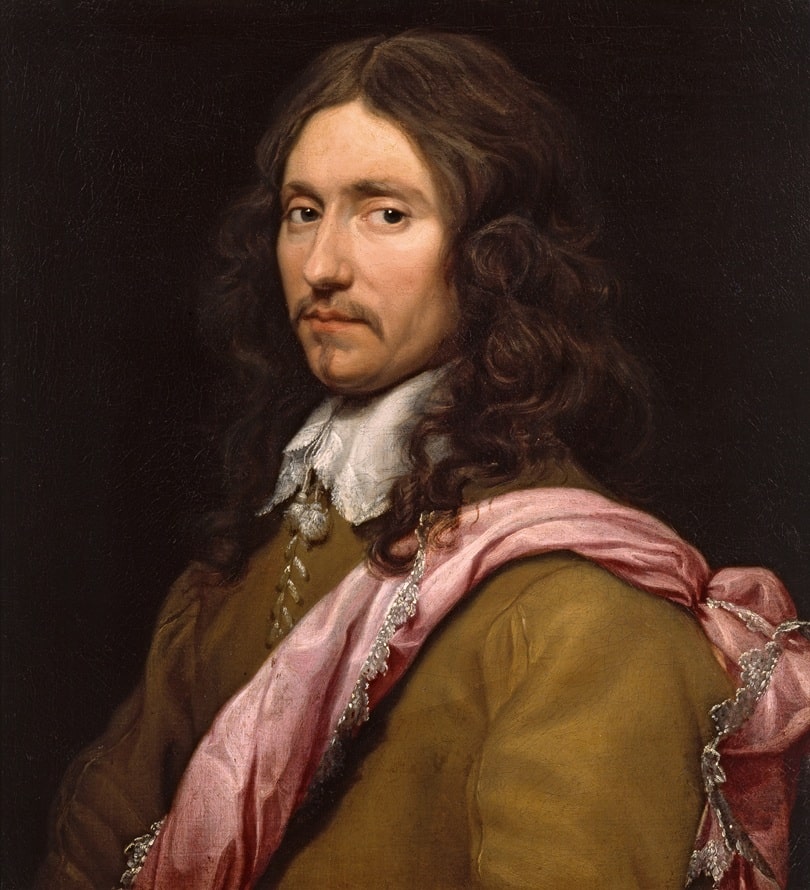
It was extremely unusual for a man of his rank to have his portrait painted by a woman. Wautier painted the scholar and cartographer – who created the first printed atlas of China and dedicated it to Leopold Wilhelm – in Chinese court dress. The connection with Archduke Leopold Wilhelm points to Wautier’s integration into an established network. A purchase receipt in the account book of the dance master De La Grené further attests that she received commissions as an artist and was paid for her work. In the adjoining cabinets, works by the Wautier siblings – portraits, devotional paintings, and altarpieces – enter into dialogue with works by contemporaries such as Peter Paul Rubens, Anthonis van Dyck, Jacob van Oost the Elder, Cornelis Meyssens, Pieter de Jode the Younger, Cornelis Galle the Elder, and Theodoor van Merlen the Younger, revealing Wautier’s artistic milieu and her significance within Flemish Baroque painting.
The collection inventory as a source
Also on display is the inventory of Archduke Leopold Wilhelm’s collection. Long thought lost, its rediscovery made it possible to prove Michaelina Wautier’s origins in Mons for the first time and to attribute three paintings in the Kunsthistorisches Museum – St. Joachim Reading, St. Joseph, and St. Joachim. The latter had been mistakenly attributed to her sister ‘Magdalena’ in the 1659 inventory, but a contemporary note on the back, likely by David Teniers the Younger, who was responsible for Leopold Wilhelm’s collection in Brussels, names ‘Michelline Woutiers’ as the artist.
Particular emphasis has been given to the painting St. Joachim, which has not been publicly displayed since 1781. X-ray analysis confirmed that the painting was originally rectangular. For the reorganisation of the imperial gallery under Charles VI, it was transformed into an oval – through drastic interventions such as bending and cutting off parts of the picture. It was not until 1967 that it was returned to a rectangular format and extensively repaired, though it remained in storage. For the current exhibition, the painting has been carefully restored in order to preserve its fragmentary character and to make the history of its format changes visible – a condition it shares with the depictions of St. Joseph and St. Joachim Reading.
Innovative, confident, and courageous
In the next room, Michaelina Wautier’s innovative spirit comes to the fore. In her SelfPortrait, she presents herself as a confident artist – at the easel with her painting tools. This was a radical act of female self-expression in art at the time, since women painters were among the first artists to depict themselves at work. By contrast, their male colleagues often presented themselves with symbols of social recognition such as gold chains or rapiers – actually reserved for the nobility – as Peter Paul Rubens did in his Self-Portrait displayed next to Wautier’s. In the monumental Triumph of Bacchus, she appears scantily clad as a Bacchante with her own face making direct eye contact with the audience – a powerful gesture of female self-assertion. Her knowledge of the male nude, likely gained through private drawing studies with models, led to the painting being misattributed to male artists for a long time, including Rubens’ workshop and Luca Giordano.
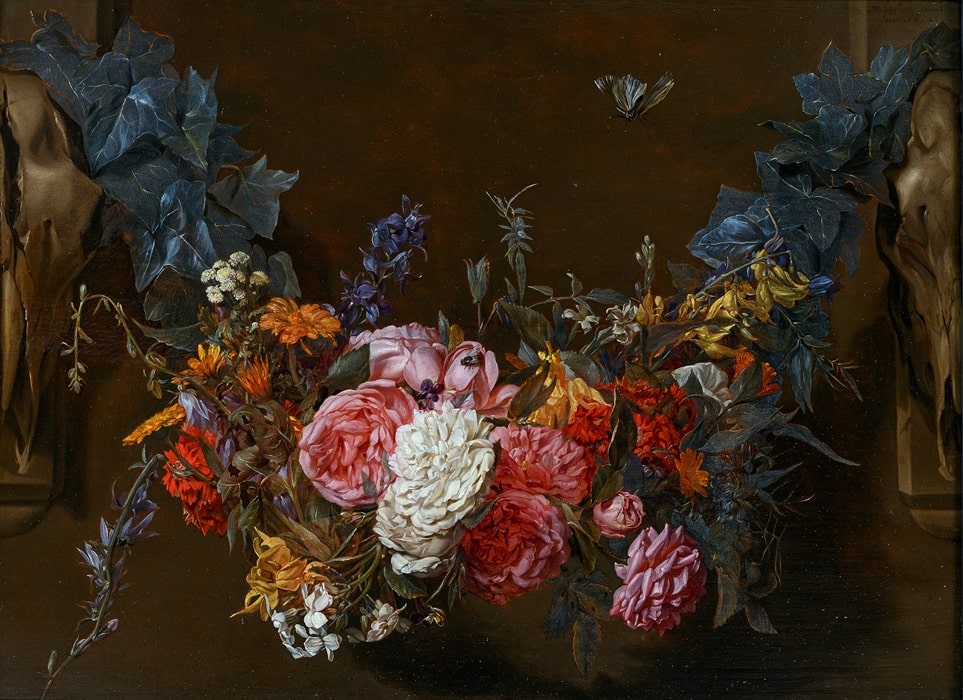
Wautier humorously and sensitively composed the series The Five Senses (1650) as childhood scenes that testify to her powers of observation and portraiture practice. Right after this, there is another genre scene: Boys Blowing Bubbles (1650/55) – an allegory of life’s transience. Her flower pieces also demonstrate her innovative spirit: the Flower Garlands painted on Antwerp panels in 1652 combine Baroque flower painting with ancient bucrania motifs – a unique approach in Flemish art. Her only known drawing – Study of a Bust of the Medici Ganymede (1640/50) – points to her deeper engagement with antiquity, possibly gained through a trip to Rome, her brother Charles, or her knowledge of local antiquities collections
Art meets AI
At the end of the exhibition, an innovative AI project invites visitors to rediscover Michaelina Wautier’s monumental painting The Triumph of Bacchus. Measuring 270 × 355 cm today, the painting was cropped on both sides in the eighteenth century. About 40 cm of the image surface was lost, and its original appearance remains unknown. In a collaboration between the Kunsthistorisches Museum and the Ars Electronica Futurelab, these missing sections have been reconstructed using artificial intelligence – based on iconographic standards, gigapixel scans, and expertise on Wautier’s technique from art historians. First presented in Deep Space 8K at the Ars Electronica Festival 2025, the reconstruction allows audiences to once again experience the original monumentality of the work.
WHEN?
Exhibition period: Tuesday, 30. September 2025 until Sunday, 22. February 2026
Opening hours:
Daily: 10 am – 6 pm
Thu: 10 am – 9 pm
WHERE?
Kunsthistorisches Museum
Maria-Theresien-Platz
1010 Vienna
COSTS?
Regular: online 22 EUR, on site 24 EUR
Reduced: online 19 EUR, on site 20 EUR


